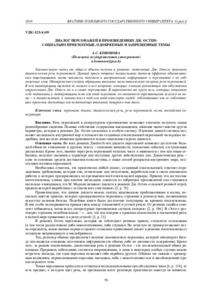Please use this identifier to cite or link to this item:
https://elib.psu.by/handle/123456789/22862Full metadata record
| DC Field | Value | Language |
|---|---|---|
| dc.contributor.author | Кононова, А. С. | - |
| dc.date.accessioned | 2018-11-26T11:17:39Z | - |
| dc.date.available | 2018-11-26T11:17:39Z | - |
| dc.date.issued | 2018 | - |
| dc.identifier.citation | Вестник Полоцкого государственного университета. Серия A, Гуманитарные науки. - 2018. - № 10 – C. 56-59. | ru_RU |
| dc.identifier.issn | 2070-1608 | - |
| dc.identifier.uri | https://elib.psu.by/handle/123456789/22862 | - |
| dc.description | Dialogues in Jane Austen’s Novels: Socially Acceptable, Approved and Tabooed Topics A. Konanava | ru_RU |
| dc.description.abstract | Значительную часть от общего объема текста в романах, написанных Дж. Остен, занимает диалогическая речь персонажей. Данный прием позволил писательнице достичь эффекта объективности повествования, когда читатель получает и воспринимает информацию о персонажах с их собственных слов. Одновременно следует обращать внимание на тематическую сторону речи персонажей. В ней закодированы сведения не только о тех вопросах, которые считали возможным для обсуждения современники Дж. Остен, но и о самих персонажах. В зависимости от круга тем, которые позволяет себе поднимать и поддерживать тот или иной персонаж, он относится окружающими (а вслед за ними – и писательницей, и читателем) к той или иной категории людей: соблюдающих или не соблюдающих приличия, достойных или недостойных внимания, доверия и так далее.= Dialogues comprise most part of Jane Austen’s novels’ texts. This allowed the writer to make narration in her novels objective, when a reader gets and perceives the information about the characters from their own words. At the same time one should pay attention to the topics of the characters’ dialogues. These topics contain information not only about the questions, which the writer’s contemporaries considered appropriate for discussion, but also about the characters themselves. Depending on the range of topics, which this or that character rises and supports, it is viewed by the other characters (as well as by the author, and the readers) as a member of this or that group. They are those who obey or disobey the social rules, those, who deserves or does not deserve attention and trust, and others. | ru_RU |
| dc.language.iso | ru | ru_RU |
| dc.publisher | Полоцкий государственный университет | ru_RU |
| dc.relation.ispartof | Веснік Полацкага дзяржаўнага ўніверсітэта. Серыя А, Гуманітарныя навук | be_BE |
| dc.relation.ispartof | Herald of Polotsk State University Series A, Humanity sciences | en_EN |
| dc.relation.ispartof | Вестник Полоцкого государственного университета. Серия A, Гуманитарные науки | ru_RU |
| dc.relation.ispartofseries | Серия A, Гуманитарные науки;2018. - № 10 | - |
| dc.rights | open access | ru_RU |
| dc.subject | Государственный рубрикатор НТИ - ВИНИТИ::ОБЩЕСТВЕННЫЕ НАУКИ::Литература. Литературоведение. Устное народное творчество | ru_RU |
| dc.subject | Персонаж | ru_RU |
| dc.subject | Диалог | ru_RU |
| dc.subject | Диалогическая речь | ru_RU |
| dc.subject | Речь персонажей | ru_RU |
| dc.subject | Тема | ru_RU |
| dc.subject | Character | ru_RU |
| dc.subject | Dialogue | ru_RU |
| dc.subject | Characters’ speech | ru_RU |
| dc.subject | English literature | ru_RU |
| dc.subject | Topic | ru_RU |
| dc.title | Диалог персонажей в произведениях Дж. Остен: социально приемлемые, одобряемые и запрещенные темы | ru_RU |
| dc.type | Article | ru_RU |
| dc.identifier.udc | 821(4).09 | - |
| Appears in Collections: | 2018, № 10 | |
Items in DSpace are protected by copyright, with all rights reserved, unless otherwise indicated.
